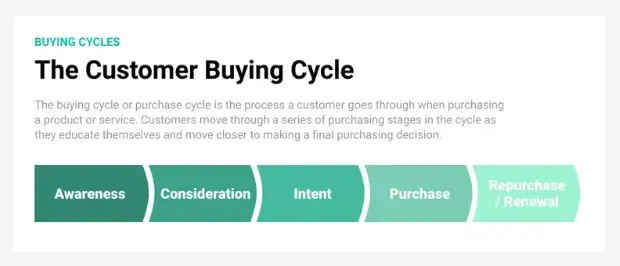Now is the best time to start and grow your online business. But how do you attract and retain clients while beating the fierce competition?
The answer is simple - develop your sales funnel based on the buyer’s cycle. Whether you want people to buy online essays from you, enroll in your course, or choose your SaaS solution, you need to know the steps before, during, and after they make a purchase.
This article is for marketers and small business owners who want to understand the importance of the buyer's cycle, learn productivity tips, and how to use this knowledge to your advantage.
95% of people visiting your site are not yet ready to buy your product. They are all in different stages of the buying cycle and have come to your site for many different reasons.
This is why it is key to understand the different parts of a buying cycle for online shoppers and to ensure your eCommerce website marketing is speaking to all people coming to your site, no matter where they are in the cycle.
By understanding this, you can maximize conversions on your eCommerce website and nurture leads appropriately.
What is a Buying Cycle and How Do You Use it on Your Online Store?
A buying cycle, also known as the purchasing cycle, is the process a new customer goes through when purchasing a product or service.
What are the Five Stages of the Buying Cycle?
- Awareness
- Consideration
- Intent
- Purchase
- Renewal
There are distinct characteristics of consumers in each stage of the buying process.
1. Awareness
The first stage of the buying cycle, awareness, starts when consumers realize they have a problem that must be solved.
These problems come from external factors, like an important event that requires a new dress, or internal factors, like the commitment to lose weight and the need for support.
Take, for example, a first-time homeowner. Before buying a house, it is unlikely that this consumer thought about what they would need to maintain their yard and landscaping.
A landlord or rental company likely maintained this even if they’ve lived in a house before. Now that they are owners, they realize it's time to consider buying a lawnmower or hiring a landscaper. The act of becoming aware is the first stage in a buying cycle.
To use this in your online business, you will want to speak about the frustrations of your customer persona.
In this way, you target a new customer base related to your product and draw them into the buying cycle. Expanding on their frustrations brings them into the next stage: consideration.
2. Consideration
Now that the consumer knows they have a problem to solve, they begin to research how to solve that problem. This is the second stage in the buying cycle, called consideration.
You can use this stage to turn your leads into new customers by educating them on all the facets of their problems.
By showing your new customers the different methods to solve their problems and what to look out for in potential solutions, you guide them to your product or service as the right solution.
New customers will no doubt be researching all of the options they could have in front of them. Showing your potential new customers that you know the industry and everything related to solving their frustrations will build trust with them.
By arming your potential new customers with questions and research that will give them the best possible outcome, you begin to bring them toward the third stage of the digital customer journey: intent.
For new customers to get to this stage, they will need to be well-informed on possible solutions and their pitfalls, including yours.
By communicating this clearly, and defining the benefits of your solution compared with your competitors, you become the knowledgeable expert and are held in a position of trust with the consumer.
3. Intent
In this stage, decision-makers will compare your product or service to your competitors.
If you’ve done your work correctly up to this point, the decision-makers will understand your product, your competitor’s product, and the pitfalls of using a competitor’s product over yours.
Decision-makers, which can be one person or a group of people, will make a decision based on three conditions: logic, emotion, and cost.
They will consider what products solve all of the frustrations they have about a particular problem or which products make the most logical sense. They will also consider emotional factors, such as trust in the website, online store, or business owner who is selling digital products to them.
4. Purchase
And finally, they will consider cost, which is both the price of the product but often is also the time needed to use the product, especially when your new customer is actually a business.
To bring consumers into the fourth stage, purchase, you will need to be strategic here. Be upfront about the differences in your product and why your product or service is superior.
Maybe you’ve verified that the source of the materials that make your product are organic and environmentally sustainable.
Or maybe your service has built a reputation by being used on over 12 million websites. Be sure to communicate this clearly on your website.
If you are unsure how to do this, check out our free eBook on 7 Steps for Turning Visitors into Customers.
5. Renewal (or re-purchase)
Here you can celebrate a little, but not too much. You still have work to do once a new customer has decided to purchase. The key here is execution.
You will want to ensure your product or service meets and exceeds your new customer's expectations. You will want to create a strong relationship with your new customer so they think of you when they need to purchase again or remain with you if your service or product is on a subscription model.
You can do this by providing support and making it easy for new customers to reach you if they have questions.
It’s a good idea to get reviews from your new customers that speak about what it was like for them before they found your product or service and how their world has changed for the better now that they have found you.
Wrap Up
In conclusion, by understanding the phase of the buyers cycle that your potential new customer is in and what questions or concerns they would have, you can speak directly to them with your website content to pull them through to purchasing your product.
Work to have content available for all cycle parts, including post-purchase, to encourage renewals.
You can use many POWR apps to communicate with new customers in your online ecommerce marketing. Try them now for free.





